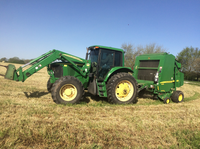Capture forage quality at harvest and maintain it to feeding
(Click the image below to view a high-resolution image that can be downloaded)
Cool season annual forages are approaching a maturity point when they will be harvested for hay. North Dakota State University Extension forage crops production specialist James Roger offers tips for capturing and maintaining forage quality through harvest, storage and feeding.
“At that harvest point, the nutritive value of the forage is captured, and there is nothing more you can do as a manager to improve it,” says Rogers. “However, from the time the forage is cut to the time that it is cured, baled, stored and consumed by an animal, there are a lot of things that can cause a loss in dry matter and nutritive value.”
At harvest
All forage plants go through various stages of growth from vegetative to reproductive. At the vegetative stage, forage quality is the highest but forage yield is the lowest. As plants mature, quality decreases and quantity increase.
At some point, a forage yield/quality compromise is reached when plant growth has reached a point of an acceptable yield and forage quality is still high enough to meet nutritional needs of livestock that consume it.
“This point varies by species,” says Rogers. “For cool season annual small grains, it is between late boot and soft dough. For other forage species, the point might be based on plant height or flower bloom.”
If forages are allowed to reach full maturity, additional yield may be gained but at the expense of lower protein and energy values and higher fiber content. Increased neutral detergent fiber in the plant can lower consumption and add to supplementation costs simply because the animal may not be able to consume enough of forage in a day to meet nutritional demands.
During the harvest process, leaf shatter from excessive handling or the improper setting of tedding or raking equipment can create dry matter losses. Hay rakes or tedders that aggressively contact the ground during tedding or raking can move soil into hay, increasing ash content.
Moisture content of forage at the time of baling is critical in order to minimize heating and soluble carbohydrate loss, dry matter loss and mold development. In general, the larger the bale, the drier hay needs to be at time of baling. For large square or round bales, a forage moisture content of 15% or less is the target.
Round bales should be made into a dense, well-shaped package and wrapped if planning to be stored outside for long periods of time. Round bales that are baled at the proper moisture content hold their shape over time compared to bales that were baled at moisture levels too high. Round bales packaged at too high a moisture content tend to squat over time which reduces their ability to shed water, leading to decay, dry matter and quality losses.
During storage
“The ultimate storage point for dry hay is in a shelter, but for many, storing round bales outside is the only option,” says Rogers. “If this is the case, store wrapped bales in a well-drained area and if possible, minimize contact with the ground.”
Ideally, bales should be placed in a north-south orientation with space between rows for air flow. Dry matter losses during storage of 2%, 5% or 10% can often occur, but dry matter losses of up to 50% can happen over time in high rainfall areas with poor storage conditions.
At feeding
“If everything has been done right to this point, harvested at optimum maturity, baled at proper moisture and stored to minimize loss, large losses can still occur at feeding,” says Rogers.
Feeding hay in a dry lot is tough, but placing bales in a feeder helps to minimize loss. The more restrictive the feeder, the lower the loss. Allocating hay amounts to what will be consumed in a day or two also helps to reduce loss, but the tradeoff is increased labor.
Ranchers should be aware that dry matter and storage losses of hay can occur at each step of the process from harvest to feeding. At each point of loss, dry matter and nutrients are being left on the ground and not being fed into the animal. These losses come at the cost of more hay required to account for the losses, additional supplementation cost due to low quality, or increased time and labor.
“In these times of inflated input costs, managing to minimize these losses are critical,” says Rogers.
NDSU Agriculture Communication - June 14, 2022
Source: James Rogers, 701-857-7682, james.rogers.1@ndsu.edu
Editor: Elizabeth Cronin, 701-231-5391, elizabeth.cronin@ndsu.edu


